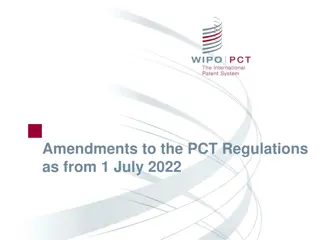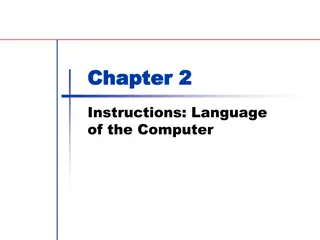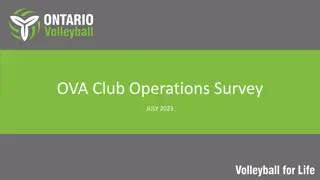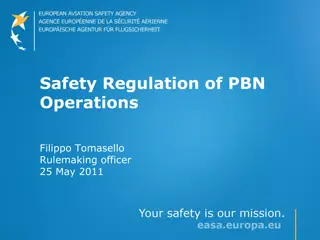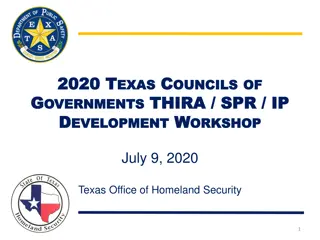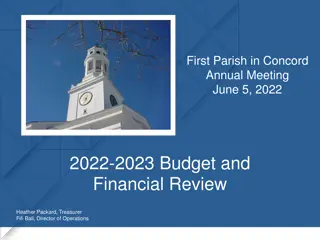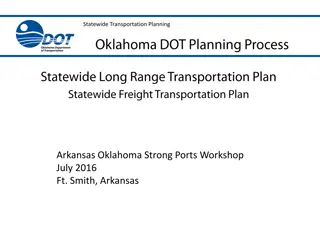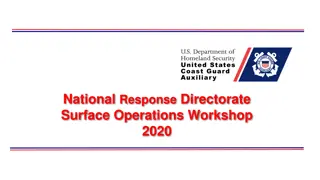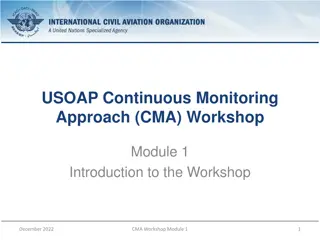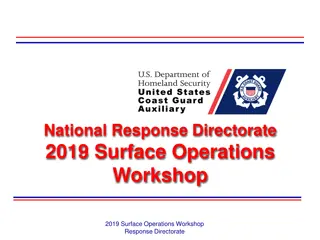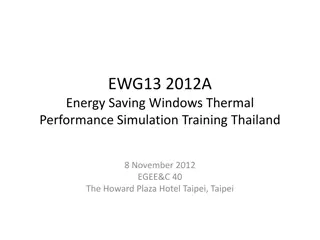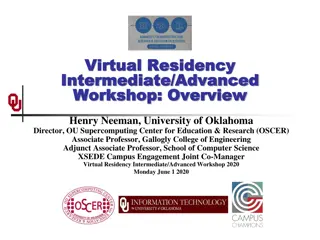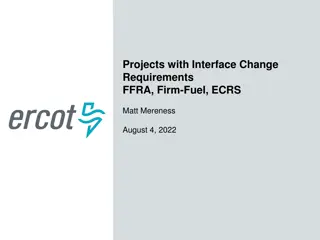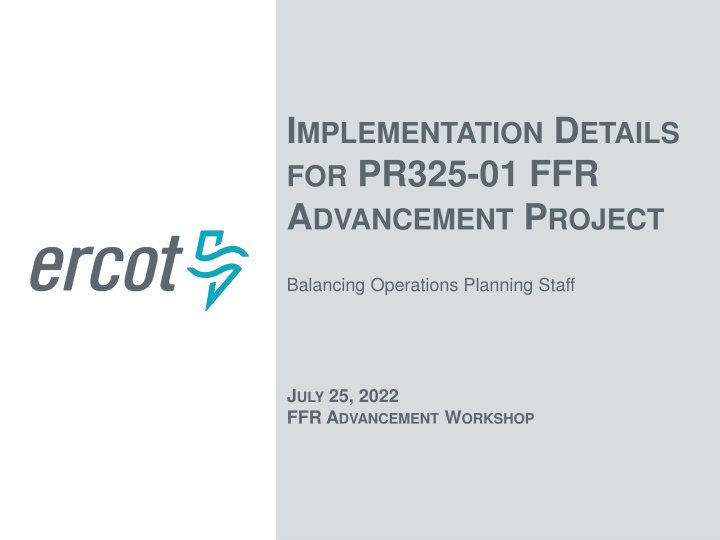
FFRA Project Implementation Details for Operations Planning Staff
"Learn about the high-level changes and protocols involved in the PR325-01 FFR Advancement project specifically focusing on balancing operations planning staff. Discover how RRS-FFR and RRS-UFR services will coexist and be implemented, along with telemetry setups and protocol sections to be un-gray boxed in this phase."
Download Presentation

Please find below an Image/Link to download the presentation.
The content on the website is provided AS IS for your information and personal use only. It may not be sold, licensed, or shared on other websites without obtaining consent from the author. If you encounter any issues during the download, it is possible that the publisher has removed the file from their server.
You are allowed to download the files provided on this website for personal or commercial use, subject to the condition that they are used lawfully. All files are the property of their respective owners.
The content on the website is provided AS IS for your information and personal use only. It may not be sold, licensed, or shared on other websites without obtaining consent from the author.
E N D
Presentation Transcript
IMPLEMENTATION DETAILS FOR PR325-01 FFR ADVANCEMENT PROJECT Balancing Operations Planning Staff JULY 25, 2022 FFR ADVANCEMENT WORKSHOP
Introduction PR325-01 FFR Advancement (FFRA) project is the second in a series of projects that are being used to implement changes associated with NPRR 863. Following is a high-level list of the changes that are being made as a part of the FFRA project. 1. Upon the full implementation of FFR as a part of this project, for any operating hour in the Day Ahead Market (DAM), a) An ESR-Gen and ESR-CLR will be able to offer, get awarded and provide* (conventional) Regulation, RRS-PFR, and (online) Non-Spin simultaneously with RRS-FFR (assuming the ESR-Gen or ESR-CLR is qualified for the AS or AS sub-type it is offering or providing). b) A NCLR will be able to offer, get awarded and provide** either RRS-FFR or RRS-UFR (assuming the NCLR is qualified for the RRS sub-type it is offering or providing). 2. RRS Offers in & Awards from DAM/SASM, RRS AS Responsibilities in COPs, Self-Arranged RRS and RRS AS Trade submissions will split by subtype namely, RRS-PFR, RRS-FFR and RRS- UFR. 3. In Real Time, new telemetry will be setup to send Ancillary Service Responsibility and Ancillary Service Schedule for RRS-FFR. The existing Ancillary Service Responsibility and Ancillary Service Schedule telemetry will continue to be used for telemetering RRS-PFR and RRS-UFR. *ESR-Gen will be required to use ONFFRRRS resource status to provide RRS-FFR in Real Time. ** NCLR will be required to use ONFFRRRSL resource status to provide RRS-FFR or ONRL resource status to provide RRS-UFR in Real Time. 2 PUBLIC 2
Introduction, continued 4. For CLRs including ESR-CLRs and Generating Units operating in synchronous condenser fast response mode, RRS-PFR Awards from DAM/SASM, RRS-PFR COP submissions, and RRS- PFR Responsibility & Schedule telemetry in Real Time for CLRs will be limited by their corresponding RRS-MW-Limit (%) or tested MW as applicable. 5. For all Resources providing RRS-FFR, RRS-FFR Awards from DAM/SASM, RRS-FFR COP submissions and RRS-FFR Responsibility & Schedule telemetry in Real Time will be limited by their respective FFR Qualified MWs. 6. There will be changes to several reports primarily to include information breakdown by RRS subtype. 3 PUBLIC 3
Protocol Sections to be Un-Gray Boxed in FFRA The following table contains a list of Nodal Protocol sections that will be un-gray boxed in this phase. In cases where only a portion of a section is being un-gray boxed, specific references have been included in parenthesis. Revision Request Section Notes / Comments NPRR863 Management Activities for the ERCOT System 3.9.1 NPRR1015 3.9.1 Management Activities for the ERCOT System NPRR1015 4.4.7.1 (9) Day-Ahead Operations NPRR1015 4.4.7.2 (3) Day-Ahead Operations NPRR1015 4.4.7.3 (4) Day-Ahead Operations NPRR1015 4.4.7.3.1 (1f) Day-Ahead Operations NPRR1079 Replaces NPRR1015 3.2.5 (3) (e) (f) (g) Needed for the reporting clarification for NPRR1015 This Section removed from scope of FFR 3.2.5 (3) (e) (f) (g) Will be included in the ECRS project Will remain grey boxed for FFR and will be done with ECRS project NPRR1015 4 PUBLIC 4
What is FFR? Resources providing RRS-FFR must respond autonomously when the frequency drops below 59.85 Hz. The total time from the time frequency first decays to a value low enough to initiate action up to the time when full Ancillary Service Resource Responsibility for RRS-FFR is delivered should be no more than 15 cycles, including all relay and breaker operating times; Response must be between 95% to 110% of Resource s Ancillary Service Resource Responsibility in 15 cycles after the frequency reached 59.85 Hz; These resources must be capable of sustaining full response for at least 15 minutes or till ERCOT recalls the deployment, whichever occurs first. Once RRS-FFR is recalled, a Resource providing RRS-FFR must restore their full RRS- FFR Responsibility within 15 minutes after the recall or as otherwise directed by ERCOT. If deployed via a VDI instruction, Resources providing RRS-FFR are expected to respond within 10 minutes. Resource providing RRS-FFR are required to install high-speed data recorder capable of measuring and recording ERCOT frequency (Hz) and MW output with a resolution of no less than 32 samples per second. 5 PUBLIC 5
FFR Deployment QSE Level (Unchanged from phase 1) QSE specific RRS-FFR MWs requests/deployments to FFR Resources will continue to be sent via ICCP*. QSE Specific FFR RRS MWs request/deployment will be non-zero when frequency reaches 59.85 Hz and zero when frequency reaches 59.98 Hz. QSE FFR Request/Deployment (MW) Frequency (Hz) 12 60.08 11 60.04 10 60.00 FFR Deployment (MW) 9 59.96 8 59.92 Frequency (Hz) 7 59.88 6 59.84 5 59.80 4 59.76 3 59.72 2 59.68 1 59.64 0 59.60 1 2 3 4 5 6 7 8 9 10 11 12 13 14 15 16 17 18 19 20 21 22 23 24 25 26 27 28 29 30 31 32 33 34 35 36 37 38 39 40 41 42 43 44 45 46 47 48 49 50 51 52 53 54 55 56 57 58 59 60 61 62 63 64 65 66 67 68 69 70 71 72 73 Time 74 75 76 77 78 79 80 81 82 83 84 85 86 87 88 89 90 91 92 93 94 95 96 97 98 99 100 101 102 103 104 105 106 107 108 109 110 111 112 113 114 115 116 117 118 119 120 121 122 123 124 125 126 127 128 129 130 131 132 133 134 135 136 137 138 139 140 141 142 143 144 145 146 147 148 149 150 151 * Refer the ICCP Handbook for details on this tag. 6 PUBLIC 6
FFR Deployment Unit Level (Some changes since phase 1) Note that for ESR-Gen and ESR-CLR, two new ICCP tags* will be created for telemetry Ancillary Service Responsibility and Ancillary Service Schedule for providing RRS-FFR. ESR-GEN is required to telemeter ONFFRRRS resource status (i.e. RST = 21) to provide RRS-FFR in Real Time. ESR-GEN must continue to telemeter RST = 21 when the ESR-CLR is carrying FFR. When providing RRS-FFR along with other Ancillary Services, FFR should be carried at the top of the ESR s capacity. This means that if the ESR-Gen has a non-zero HSL then regardless of operating mode of the ESR, the RRS-FFR responsibility should be on ESR-GEN . ESRs (ESR-GEN and ESR-CLR) providing RRS-FFR will receive SCED Base Points (BPs) and Updated Desired Base Point (UDBP) subject to the Resource's dispatch limits, which are calculated using the Resource's telemetered inputs and submitted offer curves. Following the autonomous response to an FFR event, these resources are expected to (1) set their RRS-FFR Schedule telemetry equal to 0; this allows SCED to appropriately set the Resource s BP (and thus UDBP) (2) to follow their respective UDBP. When RRS-FFR is recalled, these Resources are expected to continue to update their telemetry to reflect their capability and continue following UDBP to ramp down from the RRS-FFR deployment. Upon completion of an RRS-FFR deployment a Resource providing FFR is expected to reset RRS- FFR Responsibility and Schedule telemetry according to the Resource s capability as soon as practicable but no later than 15 minutes (or the QSE is expected to move the RRS obligation to a different Resource). * A draft of the revised ICCP Handbook has been posted to today s meeting page and/or contact ERCOT s Production Support personnel for details on this tag. 7 PUBLIC 7
Telemetry setup Example for ESRs Example below provides a high-level outline of telemetry on ESR-GEN when this Resource providing RRS-FFR is deployed. FFR-Deployed Output FFR-RRSC* HDL/HASL HSL UDBP FFR Capacity Deployed 12 12 System Lambda < Resource Offer 10 10 (4) FFR Recalled QSE RRS-FFR request = 0 (1) FFR Triggered 8 8 (6) UDBP & MW ramp to 0. MW MW 6 6 (7) RRS-FFR restored. HSL returns to pre-event level. (2) MW = FFR Responsibility 4 4 (3) QSE RRS-FFR request > 0, UDBP step to MW, QSE changes FFR-RRSC = 0, HDL/HASL = HSL (5) HSL to 0, Indicates the need to charge 2 2 0 0 1 2 3 4 5 6 7 8 9 10 11 12 13 14 Time Sequence Note that this example is intended to represent of sequence of events and is not indicative of time/duration. This sequence of events hasn t changed in comparison to phase 1 implementation. One change that is worth noting is that following implementation of FFRA project, the responsibility and schedule ICCP telemetry that is used to provide RRS-FFR at unit level will change. Draft ICCP handbook on today s meeting page has more details on this. 8 PUBLIC 8
Example Response from ESRs when providing FFR - 1 Example below provides high level summary of response expectations during a low frequency event that triggers FFR deployment for an ESR that is injecting 3 MW at the start of the event, with ESR- GEN.HSL = 10 MW, ESR-GEN.FFR = 3 MW and ESR-CLR.MPC = 0 MW. 9 PUBLIC Example for illustrative purposes only. 9
Example Response from ESRs when providing FFR 2 Example below provides high level summary of response expectations during a low frequency event that triggers FFR deployment for an ESR that is charging -5 MW at the start of the event, with ESR- GEN.HSL = 10 MW, ESR-GEN.FFR = 7 MW and ESR-CLR.MPC = -5 MW. Charging at -5 MW with HSL on GEN at 10 MW, FFR on Gen at 7 MW, BP on CLR at -5MW and MPC on CLR at 5 MW Hz Trigger MW BP PFR ESR-Gen.HSL ESR-CLR.MPC ESR-Gen.HASL 60.04 10 60.02 8 60 6 59.98 4 59.96 2 Frequency (Hz) Output (MW) 59.94 0 59.92 -2 59.9 -4 59.88 -6 59.86 -8 59.84 -10 16:00:29 16:01:12 16:01:55 16:02:38 16:03:22 16:04:05 16:04:48 16:05:31 10 PUBLIC Example for illustrative purposes only. 10
FFR From Non-Controllable Load Resources (New) Note that for NCLRs, two new ICCP tags* will be created for telemetry Ancillary Service Responsibility and Ancillary Service Schedule for providing RRS-FFR and a third new ICCP tag* will be created to provide indication of (automatic and manual) FFR deployments at resource level. NCLRs are required to telemeter ONFFRRRSL resource status (i.e. RST = 263) to provide RRS-FFR in Real Time. NCLRs can either provide RRS-UFR or RRS-FFR in Real Time. Following (automatic or manual) deployment of RRS-FFR event, NCLRs providing RRS-FFR are expected to set their RRS-FFR Schedule telemetry equal to 0. When FFR is recalled, NCLRs providing RRS-FFR are expected to reset and restore RRS-FFR Responsibility and Schedule telemetry as soon as practicable but no later than 15 minutes (or the QSE is expected to move the RRS obligation to a different Resource). 11 PUBLIC 11
FFR Qualification (Unchanged since phase 1) ERCOT is currently accepting requests from Resources interested in providing RRS-FFR. FFR qualification test will be a two-pronged test a self test that demonstrates the Resource s ability to deploy within 15 cycles of when the frequency trigger is met and to sustain response for at least 15 minutes; and a coordinated test that demonstrates the Resource s ability to change Ancillary Service Schedule for RRS-FFR telemetry in response within 15s to an ERCOT deployment. ERCOT s Registration systems will track the capacity a Resource providing RRS-FFR is qualified to provide. For all Resources providing RRS-FFR, RRS-FFR Awards from DAM/SASM, RRS-FFR COP submissions and RRS-FFR Responsibility & Schedule telemetry in Real Time will be limited by their respective FFR Qualified MWs. 12 PUBLIC 12
RRS Limits (Some changes since phase 1) Recap of phase 1 changes ERCOT has been using the methodology outlined in Other Binding Document, Procedure for Calculating Responsive Reserve (RRS) Limits for Individual Resources calculate and update, using the methodology described in the Nodal Operating Guide, to compute a RRS-MW-Limit (%) for each Resource that is qualified to provide RRS-PFR. The certified report, Responsive Reserve Limits for Generation Resources (EMIL ID NOG2-312-M , Report ID 19236) is posted on a monthly basis on ERCOT s Market Information System (MIS) | Grid | Generation page. RRS-MW-Limit (%) for Generation Resource and ESR-Gen thus generated are being tracked in ERCOT systems and are being used to limit DAM/SASM RRS-PFR Awards, validate RRS-PFR obligation submissions in COP and validate RRS-PFR Responsibility and Schedule telemetry in Real Time. FFRA project changes RRS-MW-Limit (%) (or tested MW as applicable) for CLRs including ESR-CLR AND Generation Units operating in synchronous condenser fast response mode will be tracked in ERCOT systems and will be used to limit DAM/SASM RRS-PFR Awards, validate RRS-PFR obligation submissions in COP and validate RRS-PFR Responsibility and Schedule telemetry in Real Time. 13 PUBLIC 13
Report Changes (New) Several existing reports will be affected as a result of the changes being made in the FFRA project. Below is a list of some of the report whose structure will change upon implementation of FFRA project. NP4-179-CD Total Ancillary Service Offers NP6-655-CD Total Ancillary Service Procured in SASM NP6-913-CD SASM Aggregated Ancillary Service Offer Curve NP4-19-CD Aggregated Ancillary Service Offer Curve NP8-143-CD QSE Ancillary Service Capacity Monitor NP3-989-ER 7Day Event Trigger Posting When MCPC Exceeds 50xFIP NP3-990-EX 60D SASM SASM Generation Resource AS Offers SASM Load Resource AS Offers SASM Generation Resource AS Offer Awards SASM Load Resource AS Offer Awards NP3-966-ER 60-Day DAM Disclosure Reports NP3-975-EX 60D DAM Generation Resource Data NP3-976-EX 60D Generation Resource AS Offers in DAM NP3-978-EX 60D Load Resource AS Offers in DAM NP3-974-EX 60D QSE Specific Self-Arranged AS in DAM NP3-977-EX 60 Day Load Resource Data in DAM NP3-991-EX 60D Current Operating Plan (update name to: 60-Day COP All Updates) NP1-301 60D COP Adjustment Period Snapshot (Complete COP) NP3-915-EX 3D Highest Price AS Offer Selected NP3-911-EX 2D Ancillary Services Disclosure NP3-959-EX 2D Aggregate AS Offers NP3-961-EX 2D Cleared DAM AS NP3-960-EX 2D Self-Arranged AS NP3-965-ER 60D SCED Disclosure Report NP3-967-EX QSE self arranged AS NP3-968-EX Generation Resource Data NP3-969-EX Load Resource Data NP8-501-ER Monthly Generation Resource Energy Deployment Performance Report 14 PUBLIC 14
Summary PR325-01 FFR Advancement (FFRA) project is the second in a series of projects that are being used to implement changes associated with NPRR 863. ERCOT is planning to implement the FFRA project between October 13, 2022. ERCOT will send Market Notices closer to the implementation date. FFRA project changes are scheduled to be migrated into ERCOT s Market Operations Testing Environment (MOTE) on August 12, 2022. A Market Notice will be sent confirming MOTE s availability for testing FFRA related changes (~on August 15, 2022). Draft ICCP Handbook changes have been posted on the meeting page for today s meeting. Draft EIP External Interfaces Specification and External Web Services XSD outlining changes to have been posted on XSDs page on ercot.com. ERCOT is currently accepting requests from Resources interested in providing RRS-FFR. For any specific questions or issues related to FFRA project changes please reach contact respective ERCOT Account Manager or contact ERCOT Client Services via email at ClientServices@ercot.com. 15 PUBLIC 15
APPENDIX PUBLIC 16 16
Acronyms AS - Ancillary Service BP - Base Point BPM Business Practice Manual COP - Current Operating Plan DAM - Day Ahead Market ESR - Energy Storage Resource ESR-Gen ESR Generation Resource ESR-CLR ESR Controllable Load Resource FFR - Fast Frequency Response HASL - High Ancillary Service Limit HDL - High Dispatch Limit HSL - High Sustained Limit ICCP - Inter-Control Center Protocol LSL - Low Sustained Limit NCLR - Non-Controllable Load Resource OBD Other Binding Document QSE - Qualified Scheduling Entity PFR Primary Frequency Response RRRS - Responsive Reserve Responsibility RRS - Responsive Reserve RRSC - Responsive Reserve Schedule RST - Resource Status SASM - Supplementary SCED - Security Constrained Economic Dispatch UDBP - Updated Desired Base Point UFR - Under-frequency Relay 17 PUBLIC 17
FFR Qualification Details - Self Test (Unchanged from phase 1) The following steps should be followed when conducting a Self Test for FFR: 1. Ancillary Service Resource Responsibility must be set equal to MW capacity for which the Resource seeks qualification for FFR. 2. The test is performed by adding a frequency offset such that frequency decays low enough to initiate response from the Resource. Note that the initiation setting of the under-frequency relay or similar trigger mechanism shall not be any lower than 59.85 Hz; 3. The test starts at time t0 when the frequency exceeds the initiation setting & initiates a response from the Resource. The following signals should be recorded with a resolution of no less than 32 samples per second (a) Frequency (Hz) (b) MW Output (MW) 4. Upon completion send recorded data with at least 15 minutes of data to ERCOT. The following criteria will be used to evaluate Self Test for FFR: The total time from the time frequency first decays to a value low enough to initiate action up to the time when full Ancillary Service Resource Responsibility for RRS is delivered should be no more than 15 cycles, including all relay and breaker operating times; The resource must demonstrate its ability to sustain the scheduled level of deployment for at least 15 minutes at a minimum level of 95% but not more than a maximum level of 110% of the MW capacity for which the Resource seeks qualification for FFR. Note ERCOT systems will track the capacity a Resource providing FFR is qualified to provide. 18 PUBLIC 18
ESR related BPM v5.15 Revision Summary ERCOT posted Version 5.15 of the ERCOT and QSE Operations Practices During The Operating Hour with an effective date of 10/13/2021. Changes in this revision include: 1. Update to Section 3.5 Regulation Ancillary Service Added telemetry guidance related to ESRs simultaneously carrying Regulation on both the modeled ESR- Generation Resource (ESR-GR) and ESR-Controllable Load Resource (ESR-CLR), specifically the expectations for Regulation Responsibilities and Participation Factors. 2. Update to Section 3.6 Responsive Reserve Ancillary Service Added language to clarify that QSEs should not move RRS Responsibilities while frequency is below 59.95 Hz. 3. Add section 3.9.3 Telemetry Requirements Related to IRRs Co-Located with Energy Storage Resources Add new section on telemetry guidance for ESRs co-located with IRRs, specifically related to the telemetry expectations when an ESR is self-charging from a co-located IRR. 4. Add section 3.12 Expected Primary Frequency Response for Energy Storage Resources Add new section detailing ESR Expected Primary Frequency Response for various operating conditions. Please direct any questions related to these changes to OperationsAnalysis@ercot.com 19 PUBLIC 19
PFR Expectations for ESRs when providing FFR - 1 When an ESR is providing FFR, autonomous droop based Primary Frequency Response is expected on the frequency responsive capacity that is not reserved for FFR when frequency is outside the dead- band. When discharging or idle and carrying FFR on the ESR-GR, For low frequency events, the available capacity for autonomous PFR is between the ESR-GEN HSL, minus FFR capacity, and ESR-GEN injection MW. HSL HSL FFR Capacity FFR Capacity MW Discharging 0 Idle 0 MPC MPC For high frequency events, the available capacity for autonomous PFR is between the ESR-GEN injection MW and ESR-CLR MPC. HSL HSL FFR Capacity FFR Capacity MW Idle Discharging 0 0 MPC MPC PUBLIC 20
PFR Expectations for ESRs when providing FFR - 2 When an ESR is providing FFR, autonomous droop based Primary Frequency Response is expected on the frequency responsive capacity that is not reserved for FFR when frequency is outside the dead- band. When charging and carrying FFR on the ESR-CLR (Phase 2 FFR Advancement), For low frequency events, the available capacity for autonomous PFR is between the ESR-GEN HSL and ESR-CLR charging MW. When FFR is not deployed, FFR capacity should be carried at the top of the ESR s capacity. This means that if the ESR-GEN has a non-zero HSL then regardless of operating mode of the ESR, the RRS-FFR responsibility should be on ESR-GEN. HSL = 0 HSL FFR Capacity Charging Charging 0 0 Charging FFR Capacity NPC=MPC NPC=MPC For high frequency events, the available capacity for PFR is between the ESR-CLR charging MW and ESR-CLR MPC. HSL FFR Capacity HSL FFR Capacity Charging 0 Charging 0 NPC MPC NPC=MPC PUBLIC 21
Example Response from ESRs when providing FFR 1 Example below provides high level summary of response expectations during a low frequency event that does not trigger FFR deployment for an ESR that is sitting idle, with ESR-GEN.HSL = 10 MW, ESR-GEN.FFR = 10 MW, ESR-CLR.MPC = 0 MW. Sitting at 0 MW with HSL on GEN at 10, FFR on Gen at 10 MW and MPC on CLR at 0 MW Hz Trigger MW BP PFR ESR-Gen.HSL ESR-CLR.MPC ESR-Gen.HASL 60.04 10 ESR has no frequency responsive headroom for PFR response. 60.02 8 60 6 59.98 4 59.96 2 Frequency (Hz) Output (MW) 59.94 0 59.92 -2 59.9 -4 59.88 -6 59.86 -8 59.84 -10 16:00:29 16:01:12 16:01:55 16:02:38 16:03:22 16:04:05 16:04:48 16:05:31 22 PUBLIC Example for illustrative purposes only. 22
Example Response from ESRs when providing FFR 2 Example below provides high level summary of response expectations during a low frequency event that does not trigger FFR deployment for an ESR that is sitting idle, with ESR-GEN.HSL = 10 MW, ESR-GEN.FFR = 3 MW, ESR-GEN.BP = 0 MW and ESR-CLR.MPC = 0 MW. Sitting at 0 MW with HSL on GEN at 10, FFR on Gen at 3 MW and MPC on CLR at 0 MW Hz Trigger MW BP PFR ESR-Gen.HSL ESR-CLR.MPC ESR-Gen.HASL 60.04 10 ESR has 7 MW frequency responsive headroom for PFR response for low frequency events. 60.02 8 60 6 59.98 4 59.96 2 Frequency (Hz) Output (MW) 59.94 0 59.92 -2 59.9 -4 59.88 -6 59.86 -8 59.84 -10 16:00:29 16:01:12 16:01:55 16:02:38 16:03:22 16:04:05 16:04:48 16:05:31 23 PUBLIC Example for illustrative purposes only. 23
Example Response from ESRs when providing FFR 3 Example below provides high level summary of response expectations during a low frequency event that does not trigger FFR deployment for an ESR that is sitting idle, with ESR-GEN.HSL = 10 MW, ESR-GEN.FFR = 3 MW, ESR-GEN.BP = 3 MW and ESR-CLR.MPC = 0 MW. Injecting at 3 MW with HSL on GEN at 10, FFR on Gen at 3 MW, BP on Gen at 3MW and MPC on CLR at 0 MW Hz Trigger MW BP PFR ESR-Gen.HSL ESR-CLR.MPC ESR-Gen.HASL 60.04 10 ESR has 4 MW frequency responsive headroom for PFR response for low frequency events. 60.02 8 60 6 59.98 4 59.96 2 Frequency (Hz) Output (MW) 59.94 0 59.92 -2 59.9 -4 59.88 -6 59.86 -8 59.84 -10 16:00:29 16:01:12 16:01:55 16:02:38 16:03:22 16:04:05 16:04:48 16:05:31 24 PUBLIC Example for illustrative purposes only. 24
Example Response from ESRs when providing FFR 4 Example below provides high level summary of response expectations during a low frequency event that does not trigger FFR deployment for an ESR that is charging, with ESR-GEN.HSL = 0 MW, ESR- CLR.FFR = -5 MW, ESR-CLR.BP = -5 MW and ESR-CLR.MPC = -10 MW. Charging at -5 MW with HSL on GEN at 0, FFR on CLR at -5 MW and MPC on CLR at -10 MW Hz Trigger NPC BP PFR ESR-Gen.HSL ESR-CLR.MPC ESR-CLR.LASL 60.04 10 ESR has no frequency responsive headroom for PFR response for low frequency events. 60.02 8 60 6 59.98 4 59.96 2 Frequency (Hz) Output (MW) 59.94 0 59.92 -2 59.9 -4 59.88 -6 59.86 -8 59.84 -10 16:00:29 16:01:12 16:01:55 16:02:38 16:03:22 16:04:05 16:04:48 16:05:31 25 PUBLIC Example for illustrative purposes only. 25
Example Response from ESRs when providing FFR 5 Example below provides high level summary of response expectations during a low frequency event that does not trigger FFR deployment for an ESR that is charging, with ESR-GEN.HSL = 0 MW, ESR- CLR.FFR = -3 MW, ESR-CLR.BP = -7 MW and ESR-CLR.MPC = -10 MW. 26 PUBLIC Example for illustrative purposes only. 26




